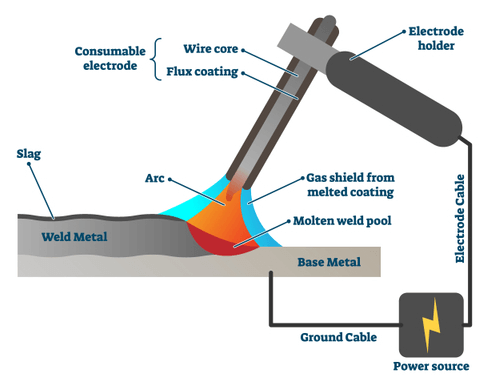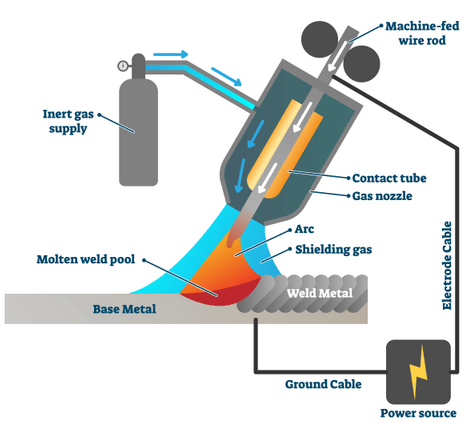Under arc welding, there are also various sub-processes available, namely MIG, TIG, and stick welding. These sub-processes differ from one another in their procedures, benefits, limitations, and applications. In this article, we will have a comprehensive look at stick welding and MIG welding and understand their differences.
About Stick Welding
Stick welding is the simplest and cost-effective arc welding process. In this process, a consumable flux-coated rod is used as the electrode. The electrode and the workpiece melt as the arc passes through them. The molten materials form a weld pool, and the pool cools down to develop a strong and durable joint between the metals. The welder can conduct the process in indoor as well as outdoor conditions, even in confined space. Furthermore, it is suitable for thick metals, and the welder needs to change the rod often as it gets consumed faster. Moreover, the process gives out significant spatter that requires cleaning. It is perfect for beginners and DIY hobbyists for quick welding.
Advantages of Stick Welding
Applicable Workpiece – You can use stick welding on any metal part, whether it is dirty or rusty. The condition of the workpiece does not affect the outcome. This opens up its applicability on variety of objects. Variety of Materials – Stick welding is applicable to a variety of materials, starting from metals to alloys. It is suitable for iron, steel, aluminum, copper, nickel, and their alloys. Perform Anywhere – Stick welding does not need any specific area or condition for operation. Therefore, you can perform it indoors and outdoors, even in windy, hot, and cold conditions. This is because the arc is strong enough not to get affected by wind or temperature. No Shielding Gas – Unlike any other arc welding process, there is no need for a shielding gas in stick welding. This is because the flux-coated electrode melts, and flux turns into vapour to protect the weld joint from surrounding conditions. Current Type – Stick welding can operated with any current type, whether it is AC or DC. As a matter of fact, DC stick welding also produces less spatter than AC.
Disadvantages of Stick Welding
The process leads to the formation of significant spatter. This needs cleaning and sanding after the process is over. Therefore, this may need more labour and time. The process is not applicable for thinner metals, especially when it is less than 1/16 inch or 18 gauges. The welder needs to change the electrode rod frequently. The finished weld part is not very neat and clean.
Application of Stick Welding
Stick welding is applicable on thick materials only. To be precise, the material needs to be at least 1/16 inch or thicker for the process to work. It is perfect for tough metals and alloys like cast iron. As far as materials go, you can use stick welding on steel alloys, ductile iron, and carbon steel. Among non-ferrous materials, you can also use it on nickel, copper, and their alloys. This process is quite popular for welding in small shops, home maintenance welding work, fencing, grill joints, and likewise. In the industry, it finds application in construction projects, shipbuilding, structural welding, manufacturing, steel fabrication, field repairing projects, and mining fields.
About MIG Welding
MIG stands for Metal Inert Gas. In the process, there are two most important aspects you have to take care of. These aspects are selecting the correct inert gas based on the metals and setting the parameters on the welding machine for perfect welding. Overall, it is a relatively simple process that beginners can learn within a few weeks. It is applicable on thin to thick metal plates. In this welding process, the welder uses a spool gun to feed the wire electrode at a constant speed. The gun releases a shielding inert gas to protect the weld joint from reacting to elements present in the surrounding air. The arc flows between the workpiece and the wire electrode, forming the joint. The joint is also quite cleaner, and there is hardly any after-work cleaning required.
Advantages of MIG Welding
Cleaner Outcome – Even though the weld joint may not be as clean as you get in TIG welding, the joint is still cleaner than stick welding. Easy Operation – Any welder with a few weeks’ of experience can perform MIG welding perfectly. The welding gun is also very easy to operate, and you can start and stop the process anytime. Variety Of Materials – It can work on all materials irrespective of their thicknesses. Starting from materials as thin as 24 gauges, you can also work with thick materials with ease. Relatively Cleaner – Depending on the experience of the welder, there could be very little to no spatter during the process. Hence, the process is cleaner than stick welding, and the finish can be smooth and slag-free. Productive – Since you can perform MIG welding continuously and there is less cleaning required, the process produces quick weld joints.
Disadvantages of MIG Welding
The process is not suitable for all metal alloys like cast iron. There could be some spatter, though very minimal, that requires cleaning. You cannot perform MIG welding in wet and windy conditions. There is always a chance of wind disrupting the process leading to porous welds. It is difficult to use MIG welding in the field as there is a need for a pressurized bottle of inert gas.
Application of MIG Welding
MIG welding is applicable on thin as well as thick materials. You can control the power output to a greater extent, which enables its application on a variety of metals without burning them. Starting from steel and their alloys to aluminum, copper, nickel, bronze, and other alloys, MIG welding is suitable everywhere. In the industry, MIG welding is popular for metal component repair, automotive manufacturing and repairing, railroad track repairing, underwater welding, construction pipe welding, and shipbuilding.
Comparison Table of Stick Vs Mig Welding
Conclusion
Both the arc welding processes are quite popular commercially. In comparison, MIG welding is more popular due to its smooth finish and more productivity. When it comes to welding thick as well as thin materials like aluminum sheet, MIG welding is perfect. However, when you are working in outdoor conditions, stick welding has no substitute. Besides, for welding cast iron, stick welding is the perfect choice. Comment * Name * Email * Website
Δ







![]()